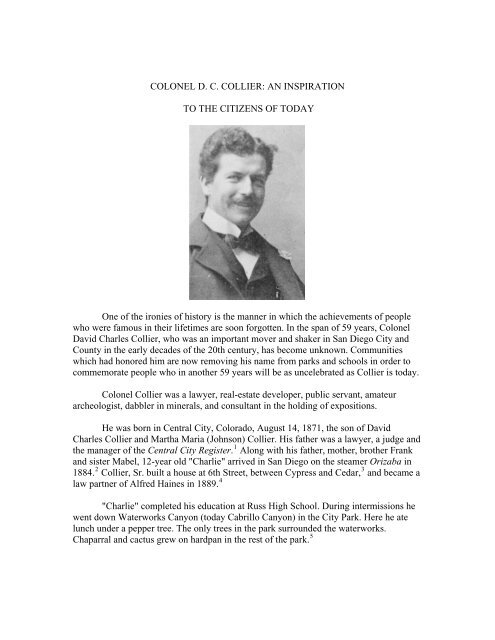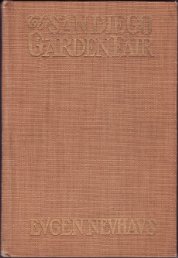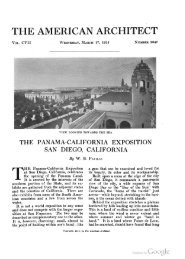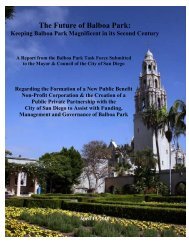Colonel David Charles Collier - Committee of One Hundred
Colonel David Charles Collier - Committee of One Hundred
Colonel David Charles Collier - Committee of One Hundred
You also want an ePaper? Increase the reach of your titles
YUMPU automatically turns print PDFs into web optimized ePapers that Google loves.
COLONEL D. C. COLLIER: AN INSPIRATION<br />
TO THE CITIZENS OF TODAY<br />
<strong>One</strong> <strong>of</strong> the ironies <strong>of</strong> history is the manner in which the achievements <strong>of</strong> people<br />
who were famous in their lifetimes are soon forgotten. In the span <strong>of</strong> 59 years, <strong>Colonel</strong><br />
<strong>David</strong> <strong>Charles</strong> <strong>Collier</strong>, who was an important mover and shaker in San Diego City and<br />
County in the early decades <strong>of</strong> the 20th century, has become unknown. Communities<br />
which had honored him are now removing his name from parks and schools in order to<br />
commemorate people who in another 59 years will be as uncelebrated as <strong>Collier</strong> is today.<br />
<strong>Colonel</strong> <strong>Collier</strong> was a lawyer, real-estate developer, public servant, amateur<br />
archeologist, dabbler in minerals, and consultant in the holding <strong>of</strong> expositions.<br />
He was born in Central City, Colorado, August 14, 1871, the son <strong>of</strong> <strong>David</strong><br />
<strong>Charles</strong> <strong>Collier</strong> and Martha Maria (Johnson) <strong>Collier</strong>. His father was a lawyer, a judge and<br />
the manager <strong>of</strong> the Central City Register. 1 Along with his father, mother, brother Frank<br />
and sister Mabel, 12-year old "Charlie" arrived in San Diego on the steamer Orizaba in<br />
1884. 2 <strong>Collier</strong>, Sr. built a house at 6th Street, between Cypress and Cedar, 3 and became a<br />
law partner <strong>of</strong> Alfred Haines in 1889. 4<br />
"Charlie" completed his education at Russ High School. During intermissions he<br />
went down Waterworks Canyon (today Cabrillo Canyon) in the City Park. Here he ate<br />
lunch under a pepper tree. The only trees in the park surrounded the waterworks.<br />
Chaparral and cactus grew on hardpan in the rest <strong>of</strong> the park. 5
At age 14, "Charlie" became a janitor, then a bookkeeper at the First National<br />
Bank. 6 While filling a tank with gas from a jet for H. D. Priens, a druggist at 4th and E<br />
Streets, he lit a match. The explosion blew out a window and nearly cost him his life. 7<br />
At 16, "Charlie" built a shack at the corner <strong>of</strong> Pacific Avenue (today Coronado<br />
Avenue) and Bacon Street in Ocean Beach. He called the shack the "Alligator Rock<br />
Lodge." 8<br />
In 1891, at age 20, <strong>Collier</strong>, Jr. became a lawyer in his father's <strong>of</strong>fice. 9 The San<br />
Diego Union, August 21, 1895, mentioned that he got in a fist fight with J. P. Hirschler in<br />
the latter's bookstore. 10<br />
Following his father's death in 1899, 11 <strong>Collier</strong> became a law partner <strong>of</strong> Judge W.<br />
P. Andrews. 12 In 1900 he entered a new partnership with Sam F. Smith. 13 As many <strong>of</strong> his<br />
clients were unable to pay him in cash, they gave him real estate they considered<br />
worthless. 14 He subdivided this land, put in utilities, planted trees, and sold it through the<br />
Ralston Realty Co., organized in 1904. 15 In 1905 he organized the Easton-<strong>Collier</strong> Co., 16<br />
in 1908 the Western Investment Co., 17 and in 1909 D. C. <strong>Collier</strong> and Co. 18 Through these<br />
companies, he sold lots in Ocean Beach, Point Loma, Pacific Beach, University Heights,<br />
Normal Heights, North Park, East San Diego, Encanto, La Mesa, and Ramona.<br />
A marriage to Ella May Copley in San Diego, January 1, 1896, 19 ended in<br />
divorce, November 11, 1914. 20 His wife was the sister <strong>of</strong> Congressman Ira C. Copley <strong>of</strong><br />
Illinois, who would later become the owner <strong>of</strong> the San Diego Union and Evening<br />
Tribune. <strong>Collier</strong>, his wife, and two sons, <strong>David</strong> Copley and Ira Clifton, lived at Alligator<br />
Rock Lodge. The lodge had become a large house with a bathing pool and a Japanese<br />
garden. 21<br />
Ruth E. Everson became his second wife, November 14, 1915. Following her<br />
death, August 28, 1916, 22 he married Clytie B. Lyon, December 13, 1919. 23<br />
His son <strong>David</strong> became a military aviator who was killed in a crash during World<br />
War I. Ira, from whom he was estranged, became a newspaperman in New York City. 24<br />
<strong>Collier</strong> had a stepdaughter, Clytie, by his third wife.<br />
As his business prospered, <strong>Collier</strong> took a leading role in the community as a<br />
financier, politician and citizen. He won a case against the County Auditor in January<br />
1900 when Judge Torrance ruled interests and penalties cannot be charged on costs <strong>of</strong><br />
property being sold to redeem taxes. 25<br />
<strong>Collier</strong> owned the first phonograph, a Berliner Gramophone, 26 and the first<br />
automobile in San Diego, 27 an Oldsmobile he purchased in 1900. It made 25 miles per<br />
hour and could cover 50 miles on three quarts <strong>of</strong> gasoline.
In 1905 <strong>Collier</strong> persuaded the City Council to override the veto <strong>of</strong> Mayor John L.<br />
Sehon and to purchase water from the J. D. Spreckels' Southern California Mountain<br />
Water Company. 28<br />
Seeking new fields, he bought five mines in the Julian-Banner district in 1900 and<br />
the Santa Maria Land and Water Co. in Ramona in 1905. 29 After that he built a home on<br />
stilts near Hatfield Creek on the road to Ballena.<br />
Like other men <strong>Collier</strong> sought the goodwill <strong>of</strong> his fellow citizens, but, more than<br />
any other factor, he was propelled into a whirlwind <strong>of</strong> activities by the irrepressible force<br />
<strong>of</strong> his exuberant energies.<br />
From 1907 to 1911 he served on the staff <strong>of</strong> California Governor J. N. Gillette,<br />
who gave him the title <strong>of</strong> "<strong>Colonel</strong>." 30 In 1907 he built a home and poultry farm in La<br />
Mesa Springs. 31 In 1908-09 he built a railroad line from San Diego to Ocean Beach. 32 In<br />
1908 he was president <strong>of</strong> the San Diego Chamber <strong>of</strong> Commerce, 33 and organized San<br />
Diego's reception for the U.S. Navy's Great White Fleet. 34 In 1909 he built the Ocean<br />
Beach School, planted trees and put a road through <strong>Collier</strong> Park in Point Loma, 35 and<br />
donated decomposed granite to surface the driveways and sidewalks <strong>of</strong> El Cajon<br />
Avenue. 36 In 1910 he organized the Aero Club <strong>of</strong> San Diego. 37 In 1911 he persuaded<br />
Glenn H. Curtiss to bring his aviation company to North Island, 38 and helped secure<br />
passage <strong>of</strong> legislation from the State <strong>of</strong> California giving San Diego title to its tidelands<br />
from National City to Point Loma. 39 In 1912 he organized the Order <strong>of</strong> Panama. 40 In<br />
1913 he thought up the idea <strong>of</strong> using tiles from the ruins <strong>of</strong> the Spanish Presidio to make<br />
the cross in Presidio Park. 41<br />
A meeting <strong>of</strong> the Chamber <strong>of</strong> Commerce, July 27, 1908, to investigate charges<br />
that the law firm <strong>of</strong> Crane and Andrews had tarnished the reputation <strong>of</strong> San Diego<br />
businesses by declaring that 17 <strong>of</strong> them were on the verge <strong>of</strong> bankruptcy erupted into a<br />
fight between <strong>Collier</strong> and Andrews. Taking <strong>Collier</strong>'s side, the Chamber ruled that Crane<br />
and Andrews had been "disloyal to the people <strong>of</strong> San Diego." 42<br />
<strong>Collier</strong> was not so successful, August 3, 1908, when at a political meeting in the<br />
Garrick Theater, he rose from the audience to protest an unscheduled speech by Captain<br />
John L. Sehon. The audience yelled "Sit down!" and "Go back to the woods!" <strong>Collier</strong>'s<br />
quick-tempered response did not win him friends:<br />
"Yell, yell! Yell, I want you dogs to yell every time I snap my fingers. Yell and<br />
bark. Every time I snap my fingers, I want you dogs to bark." 43<br />
After taking his first flight in a Curtiss biplane flown by <strong>Charles</strong> Hamilton, <strong>Collier</strong><br />
told a reporter:<br />
"When I die, I hope they'll have biplanes for the funeral, for I know I'll come back<br />
to life for a second time then and be able to wave goodbye to the bunch just<br />
before the clods begin to fall." 44
The most important civic posts <strong>Collier</strong> held in San Diego were those <strong>of</strong> Director-<br />
General <strong>of</strong> the Panama-California Exposition from 1909 to 1912, and President <strong>of</strong> the<br />
Exposition from 1912 to 1914. 45 He gave $500,000 <strong>of</strong> his own money to the Exposition,<br />
served without pay, and paid his own travel expenses on promotional trips to<br />
Washington, D.C., South America and Europe. 46 Consequently, his real estate business<br />
foundered, he was burdened by debts, and he was compelled to resign the presidency,<br />
March 5, 1914. 47<br />
<strong>Collier</strong> chose the central mesa <strong>of</strong> Balboa Park as the site for the Exposition, 48<br />
selected California Mission as the architectural style, 49 approved hiring Bertram Goodhue<br />
as consulting architect, 50 and decided on the Indian background <strong>of</strong> the Southwest as the<br />
Exposition's main cultural theme. 51 He was a founder <strong>of</strong> the San Diego Museum (today<br />
Museum <strong>of</strong> Man), a manager <strong>of</strong> the American School <strong>of</strong> Social Research in Santa Fe,<br />
New Mexico, and a friend <strong>of</strong> Dr. Edgar L. Hewett, director <strong>of</strong> the School <strong>of</strong> American<br />
Archaeology and first director <strong>of</strong> the San Diego Museum. 52<br />
<strong>Collier</strong>'s role in enlisting U.S. Congressional support <strong>of</strong> the San Diego Exposition<br />
did much to advertise San Diego, but he failed to get government recognition because <strong>of</strong><br />
opposition from San Francisco, which was organizing an exposition <strong>of</strong> its own. San<br />
Franciscans had acquired the support <strong>of</strong> conservatives in the Republican party. 53 When<br />
the conservatives succeeded in defeating the San Diego Exposition's bid for recognition,<br />
their triumph caused <strong>Collier</strong> to join the Progressive wing <strong>of</strong> the party. 54<br />
William Kettner, a San Diego Democrat, who was elected to Congress in<br />
November 1912, managed in his mild, un-<strong>Collier</strong>-like way, to secure the recognition<br />
<strong>Collier</strong> had sought. Since President Woodrow Wilson and Kettner belonged to the same<br />
party, the recognition went through speedily, without the intrigues that had beset<br />
<strong>Collier</strong>. 55<br />
To show they approved <strong>of</strong> <strong>Collier</strong>'s efforts for the Exposition, hundreds <strong>of</strong> San<br />
Diegans attended a reception in his honor, held at the Spreckels Theater, April 22, 1914.<br />
As Judge Ernest Riall presented him with a loving cup, his admirers shouted "What's the<br />
matter with <strong>Collier</strong>?", followed by the response, "He's all right!" 56<br />
<strong>Collier</strong> told his enthusiastic audience that he had accepted the presidency <strong>of</strong> the<br />
Pacific Southwest Railway. The railway would bring iron ore and coal from Colorado to<br />
San Diego, from which place ships would carry it around the world. He concluded:<br />
I feel I am again spending my energy for that town whose virtue, when it is once<br />
in a man's blood, makes <strong>of</strong> him a San Diegan in this life and in the life to come. 57<br />
Finding the Pacific Southwest Railway to be more talk than substance, <strong>Collier</strong><br />
bought back ownership <strong>of</strong> D. C. <strong>Collier</strong> and Co. in May 1914. 58 Still struggling with<br />
financial problems, he resumed his law practice in March 1915. 59 Panama-California
International Exposition directors appointed him a public relations commissioner in<br />
February 1916. 60<br />
As a trustee <strong>of</strong> the defunct Wonderland Park in Ocean Beach, <strong>Collier</strong>, in April<br />
1917, approved the transfer <strong>of</strong> ownership <strong>of</strong> animals in cages at the northeast perimeter <strong>of</strong><br />
the Exposition to the newly-formed San Diego Zoo. The Zoo paid $500 for the animals<br />
and the trustees waived a $2,000 balance. 61<br />
Also in April, <strong>Collier</strong> ran for City Council, but, owing to his championship <strong>of</strong><br />
George W. Marston for mayor against popular Louis J. Wilde, he was rejected in the<br />
April 3 election. 62 By claiming Wilde would refuse to serve, if he—<strong>Collier</strong>—were<br />
elected, he made himself look ridiculous. 63<br />
After the United States entered World War I, <strong>Collier</strong> and Kettner <strong>of</strong>fered<br />
Exposition buildings, land at Linda Vista, the site <strong>of</strong> Wonderland Park, and <strong>Collier</strong> Park<br />
to the U.S. Army 64 and then to the U.S. Navy 65 for the duration <strong>of</strong> the war. The Navy<br />
accepted the Exposition buildings as a training center. After sparring between Los<br />
Angeles and San Diego, in which <strong>Collier</strong> did not figure, the U.S. Army chose Linda Vista<br />
Mesa, consisting <strong>of</strong> 12,720 acres, as the site for Camp Kearny. 66<br />
Taking advantage <strong>of</strong> contacts he had made while promoting the Pacific Southwest<br />
Railway, <strong>Collier</strong> left San Diego in 1918 to seek employment in Chicago. San Diego<br />
newspapers did not report the nature <strong>of</strong> his Chicago activities. His reputation as an<br />
Exposition promoter and Republican being known in Washington, D.C., President<br />
Warren G. Harding appointed <strong>Collier</strong> as a representative to the 1922 Brazilian Centennial<br />
Exposition in Rio de Janeiro. At the end <strong>of</strong> the Fair, the Brazilian government declared<br />
<strong>Collier</strong> and his wife guests <strong>of</strong> the nation and arranged for them to tour the principal states<br />
<strong>of</strong> the country. 67<br />
<strong>Collier</strong> returned to San Diego in 1924 and resumed selling real estate in a "drivein"<br />
<strong>of</strong>fice at 1050 Ninth Street. His friends greeted him with a banquet at the San Diego<br />
Hotel. When his turn to speak came, <strong>Collier</strong> praised the cooperation that had made the<br />
Panama-California Exposition possible. 68<br />
<strong>Collier</strong> sold properties at Loma Portal, Wonderland Beach, Point Loma Heights,<br />
and Sunshine Gardens. 69 His firm was responsible for the demolition <strong>of</strong> Wonderland<br />
Casino 70 and the construction <strong>of</strong> beach houses, cottages, and apartment houses from<br />
Voltaire Street to Point Loma Avenue. 71<br />
Accepting the Director-Generalship <strong>of</strong> the United States Sesquicentennial to be<br />
held at Philadelphia in 1926 at a salary <strong>of</strong> $25,000 a year, <strong>Collier</strong> left San Diego in<br />
February 1925. 72 He resigned, October 29, 1925, after Philadelphia Mayor Kendrick cut<br />
the number <strong>of</strong> exhibit buildings from seven to two and an auditorium. 73 The Republic <strong>of</strong><br />
Panama employed <strong>Collier</strong> as an exposition consultant in 1925-26. 74 Nothing concrete<br />
resulted from this enterprise.
Information is not available regarding <strong>Collier</strong>'s activities during the next six years.<br />
He visited or lived at times in Philadelphia, Chicago and New York City. In 1929 he was<br />
admitted to the Illinois bar. 75 He may have acted as an intermediary in the sale <strong>of</strong> goods<br />
from Brazil. In 1930 he contributed toward developing the theme <strong>of</strong> the 1933 Century <strong>of</strong><br />
Progress Exposition in Chicago. 76<br />
In the fall <strong>of</strong> 1930, <strong>Collier</strong> returned to San Diego and resumed the practice <strong>of</strong><br />
law. 77 He lived on Park Boulevard, but visited a retreat near Ramona, possibly his former<br />
home at Ballena, whenever he could. Carl Heilbron, his former partner, owned the retreat.<br />
Much <strong>of</strong> <strong>Collier</strong>'s practice came from clients in the Ramona area. 78<br />
In June 1932, <strong>Collier</strong> came in fifth in an election for the Board <strong>of</strong> Supervisors. As<br />
a person who had spent most <strong>of</strong> his life selling real estate, he, not surprisingly, favored<br />
lowering property taxes. 79<br />
Resilient by nature, a defeat could not keep <strong>Collier</strong> down for long. In 1931 he<br />
declared that San Diego could make its waterfront as attractive as Balboa Park, if it held a<br />
Centennial Exposition there. 80 Most people in San Diego ignored the suggestion.<br />
After Frank Drugan secured promises <strong>of</strong> federal and industrial support and <strong>of</strong><br />
exhibits from Chicago's Century <strong>of</strong> Progress Exposition, power brokers in San Diego<br />
endorsed Drugan's plan. They chose Balboa Park as the site for the California Pacific<br />
International Exposition, to be held in 1935-36. No one thought to ask <strong>Collier</strong> for his<br />
opinions. 81<br />
On November 13, 1934, <strong>Collier</strong> died <strong>of</strong> a heart attack at Scripps Memorial<br />
Hospital in La Jolla. 82 He was 63 years old. Funeral services were held November 15, at<br />
the Bradley-Woolman funeral parlor, under the auspices <strong>of</strong> the San Diego Lodge No. 35,<br />
<strong>of</strong> the Order <strong>of</strong> Masons. He was buried in the Masonic plot at Mount Hope cemetery in<br />
San Diego. 83<br />
In 1936 Mrs. <strong>Collier</strong> moved back East to live with her daughter. After she died,<br />
April 28, 1968, her body was taken to San Diego for interment alongside her husband's at<br />
Mount Hope Cemetery. 84<br />
<strong>Collier</strong>'s death prevented him from getting permission <strong>of</strong> the U.S. Congress to<br />
pursue a suit to win title from the U.S. Government for land at Fort Rosecrans. He<br />
claimed the government did not have clear title. If his suit had been successful, <strong>Collier</strong><br />
would have received 75 percent <strong>of</strong> the pr<strong>of</strong>its from the sale <strong>of</strong> 85 estates. Judge George<br />
Thompson, in the Superior Court, July 27, 1937, canceled <strong>Collier</strong>'s filing fee and<br />
discharged him as administrator <strong>of</strong> the estates as he was no longer living. 85 The suit was<br />
another <strong>of</strong> <strong>Collier</strong>'s bold schemes. If he had won, he would again have become rich. As it<br />
turned out, he was close to bankruptcy when he died. His widow was left with $2,000 in<br />
uncollected fees for legal services and a debt <strong>of</strong> over $42,000 in claims against her<br />
husband's estate. 86
On October 11, 1936, in the second year <strong>of</strong> the California-Pacific International<br />
Exposition, a plaque designed by San Diego sculptor Frederick W. Schweigardt,<br />
honoring <strong>Collier</strong>, was erected on the west wall <strong>of</strong> the California Quadrangle in Balboa<br />
Park. 87 It shows <strong>Collier</strong> in pr<strong>of</strong>ile signing his name, the same image used in innumerable<br />
real estate ads. Beneath the salutation, "Yours for California," and <strong>Collier</strong>'s signature are<br />
the words:<br />
COLONEL DAVID CHARLES COLLIER<br />
A man <strong>of</strong> vision - a dynamic leader - a developer and builder<br />
A great and lovable character<br />
The creative genius <strong>of</strong> the Panama-California Exposition <strong>of</strong> 1915<br />
An inspiration to the citizens <strong>of</strong> today. 88<br />
Archaeologist and director <strong>of</strong> the San Diego Museum from 1916 to 1929, Dr.<br />
Edgar L. Hewett paid tribute to <strong>Collier</strong> in a 1935 issue <strong>of</strong> El Palacio. His words are<br />
quoted because they convey a view <strong>of</strong> <strong>Collier</strong> as an exponent <strong>of</strong> "rugged individualism,"<br />
with all the ruthlessness the name implies:<br />
<strong>One</strong> can only think <strong>of</strong> <strong>Colonel</strong> <strong>Collier</strong> as tremendously alive. He was the most<br />
dynamic personality I have ever known; a product <strong>of</strong> human evolution well<br />
described by the term "rugged individualism." Every believer in humanity must<br />
hope and pray that the type may survive and increase. 89<br />
<strong>Collier</strong> had many friends and enemies in San Diego. He was a blustery,<br />
extroverted person with an ebullient manner that recalled Theodore Roosevelt's overflowing<br />
personality. Recognizing in him a kindred spirit, Roosevelt <strong>of</strong>fered <strong>Collier</strong> the<br />
post <strong>of</strong> colonel in a regiment he was trying to form for duty during World War I. 90<br />
<strong>Collier</strong>'s bustling mannerisms, his strapping figure, his leonine mane <strong>of</strong> hair, and<br />
the flamboyant clothes he wore were on a colossal scale. After returning from a visit to<br />
Brazil in 1912, he appeared at public meetings booted and spurred, with a striped poncho<br />
made <strong>of</strong> alpaca hair, a wide belt with knife attached, and an enormous sombrero on his<br />
head. 91 Small wonder that a New York reporter asked, "Is he real or is this just theatrical<br />
makeup for a Westerner?" 92<br />
When asked why for 40 years he had worn a five-gallon Stetson hat, a No. 18<br />
turndown collar, and a Windsor tie, he replied:<br />
"Oh, I just like the combination. It makes me easy to find in a crowd. Few other<br />
men would wear such a getup." 93<br />
A product <strong>of</strong> the crass, commercial times Sinclair Lewis satirized in Babbitt,<br />
<strong>Collier</strong> was always ready with a glad-hand and a cheerful slogan. Even maverick editor<br />
<strong>of</strong> the San Diego Herald, Abraham Sauer, fell temporarily under <strong>Collier</strong>'s spell, June 22,<br />
1911, when he asked:
"If it takes a steamer fifteen minutes to get up steam, how long will it take<br />
<strong>Collier</strong>? The answer is one second exactly, for that is what <strong>Colonel</strong> <strong>Collier</strong> did<br />
upon arrival. He exuded steam, injected it into the backbones <strong>of</strong> the dallying,<br />
shilly-shallying, doubting Thomases until, despite themselves and their<br />
knockings, backslidings and evasions, they cheered his words to the echo." 94<br />
<strong>Collier</strong>'s popularity among members <strong>of</strong> Congress from both parties and among<br />
businessmen from South America was stupendous. All these up-and-coming people<br />
recognized that he was one <strong>of</strong> them . . . a gregarious, confident man with schemes for<br />
making money and advancing society that dazzled the mind. Yet the hype was done with<br />
humor, with a pat on the back, and a wink <strong>of</strong> the eye.<br />
<strong>Collier</strong> was vulnerable as a politician. San Diegans saw the no-holds barred,<br />
brass-knuckle side <strong>of</strong> his character in his feuds with mayors John L. Sehon, 95 Grant<br />
Conard, 96 and Louis J. Wilde. 97 After his disillusionment with the Republican Old Guard<br />
in 1912, he aligned himself with George W. Marston, G. Aubrey <strong>David</strong>son, Joseph W.<br />
Sefton, Jr., and Carl Heilbron. 98 A front man for Marston in the 1917 mayoral election,<br />
he tried to bring Marston's alo<strong>of</strong> character within touch <strong>of</strong> the masses. He failed, not only<br />
because his attacks on his opponents were outlandish, but also because, in dirt-slinging<br />
warfare, his opponents (men like Sehon and Wilde) were as opportunistic and bombastic<br />
as he.<br />
There was personal side to <strong>Collier</strong> that was deeper and quieter than his boisterous<br />
public mask. We can speculate why <strong>Collier</strong> deferred to men whom he considered<br />
superior. Did he, like Babbitt, know there was more to life than camaraderie and boastful<br />
promises? Did he feel that by contact with polished and pr<strong>of</strong>essional people, like George<br />
W. Marston and Dr. Edgar L. Hewett, he could somehow smooth out his own crudities<br />
and imperfections? We will never know.<br />
Perhaps the numerous organizations <strong>Collier</strong> belonged to can give us an indication<br />
<strong>of</strong> his expansive, forward-looking character. These were the Masons, Shriners, Elks,<br />
Archaeological Institute <strong>of</strong> America, National Geographic Society, California Historical<br />
Society, Sons <strong>of</strong> Colorado Pioneers, San Diego Chamber <strong>of</strong> Commerce, Ramona<br />
Chamber <strong>of</strong> Commerce, Order <strong>of</strong> the Liberty Bell, Chicago Athletic Club, San Diego<br />
Yacht Club, San Diego Rowing Club, Sojourners <strong>of</strong> Pen and Pencil, Philadelphia<br />
Boosters' Club, Brazilera de Imprensa, and Instituto Geographical e historico de Bahia,<br />
Brazil. 99<br />
<strong>Colonel</strong> <strong>David</strong> <strong>Charles</strong> <strong>Collier</strong>: an inspiration to the citizens <strong>of</strong> today.
________________________________________________________________________<br />
1. Samuel F. Black, San Diego County, California, A Record <strong>of</strong> Settlement, Organization,<br />
Progress and Achievement, (Chicago, 1913), V. 2, 108.<br />
2. San Diego Union, April 29, 1884, 3.<br />
3. San Diego Union, June 18, 1885, 3.<br />
4. Leland Ghent Stanford, San Diego's LL.B (Legal Lore and the Bar (San Diego, 1968),<br />
120.<br />
5. San Diego Sun, December 30, 1916.<br />
6. Black, 108.<br />
7. San Diego Union, August 3, 1969, G-1.<br />
8. Ruth Varney Held, Beach Town: Early Days in Ocean Beach (San Diego, 1975), 142.<br />
9. San Diego Union, August 20, 1891, 5.<br />
10. San Diego Union, August 23, 1895, 5.<br />
11. San Diego Union, August 12, 1899, 5.<br />
12. San Diego Union, November 16, 1899, 5.<br />
13. San Diego Union, August 4, 1900, 6.<br />
14. San Diego Sun, November 14, 1934, B-1.<br />
15. San Diego Union, May 16, 1905, 5.<br />
16. San Diego Union, January 13, 1905, 3.<br />
17. Emil C. Reinbold, Scrapbook, San Diego Historical Society Research Library.<br />
18. Reinbold, Scrapbook.<br />
19. San Diego Union, January 2, 1896, 5.<br />
20. San Diego Evening Tribune, July 23,1914, 8; San Diego Sun, November 11, 1914, 1.<br />
21. Winifred <strong>David</strong>son, "The Birthplace <strong>of</strong> Large Ideas," Ocean Beach News, March 30,<br />
1934, 1.
22. San Diego Union, August 29, 1916, II, 9.<br />
23. San Diego Union, November 14, 1934, B-2.<br />
24. San Diego Sun, November 14, 1934, B-1.<br />
25. San Diego Union, November 16, 1900, 5; Held, 143.<br />
26. Held, 142.<br />
27. San Diego Union, February 13, 1900, 6.<br />
28. San Diego Union, October 30, 1905, 6.<br />
29. San Diego Union, January 6, 1900, 5; <strong>Charles</strong> R. Le Menager, Ramona and<br />
Roundabout (Eagle Park Publishing Co., 1989), 121.<br />
30. San Diego Union, April 28, 1907, 2.<br />
31. San Diego Union, March 20, 1907, 14.<br />
32. San Diego Union, May 1, 1909, II, 9.<br />
33. San Diego Union, January 14, 1908, II, 9.<br />
34. San Diego Union, March 5, 1908, 3.<br />
35. San Diego Park Board Minutes, December 4, 1908, City Clerk's Office; San Diego<br />
Union, March 9, 1909, 7.<br />
36. San Diego Union, March 11, 1909, 8.<br />
37. San Diego Union, November 2, 1909, 5; January 30, 1910, 6.<br />
38. San Diego Sun, January 26, 1931.<br />
39. San Diego Union, March 12, 1911, II, 9.<br />
40. San Diego Sun, January 5, 1912, 2.<br />
41. San Diego Union, September 27, 1913, 3.<br />
42. San Diego Union, July 28, 1908, II, 9.<br />
43. San Diego Union, August 4, 1908, 1.<br />
44. San Diego Union, January 26, 1910, 6.<br />
45. San Diego Union, November 23, 1911, II, 11.
46. San Diego Union, March 9, 1914, 1; San Diego Sun, November 14, 1934, B-1.<br />
47. San Diego Union, March 9, 1914, 1; San Diego Sun, March 30, 1914, 1.<br />
48. Letter, John C. Olmsted to George W. Marston, July 7, 1911, George W. Marston<br />
File, San Diego Historical Society Research Library.<br />
49. San Diego Sun, June 18, 1910, 7.<br />
50. San Diego Union, January 28, 1911, 10.<br />
51. San Diego Union, September 8, 1909, 1; San Diego Sun, September 8, 1909, 2.<br />
52. San Diego Sun, April 27, 1911, 3.<br />
53. San Diego Union, February 5, 1912, 6.<br />
54. San Diego Union, February 29, 1912, 10.<br />
55. San Diego Sun, May 21, 1913, 8.<br />
56. San Diego Examiner, April 24, 1914, 1.<br />
57. San Diego Union, April 23, 1914, 1.<br />
58. San Diego Sun, May 9, 1914, 9.<br />
59. San Diego Union, March 9, 1915, 4.<br />
60. San Diego Union, February 5, 1916, 9.<br />
61. Harry M. Wegeforth and Neil Morgan, It Began With a Roar (San Diego, 1969), 81.<br />
62. San Diego Union, April 4, 1917, 1.<br />
63. San Diego Union, March 23, 1917, 8.<br />
64. San Diego Sun, April 7, 1917, 1; San Diego Union, April 24, 1917, 2.<br />
65. San Diego Sun, May 1, 1917, 1.<br />
66. Richard Pourade, Gold In The Sun (San Diego, 1965), 226.<br />
67. Carl H.Heilbron, History <strong>of</strong> San Diego County (San Diego, 1936), 172.<br />
68. San Diego Union, March 27, 1924, 4.<br />
69. San Diego Union, July 20, 1924, 9.
70. San Diego Union, October 5, 1924, Building, 4.<br />
71. San Diego Union, November 27, 1924, 20; November 30, 1924, Building, 4;<br />
February 15, 1925 Building, 3.<br />
72. San Diego Union, February 4, 1925, 24.<br />
73. San Diego Union, October 30, 1925, 16.<br />
74. Heilbron, 172.<br />
75. San Diego Union, November 14, 1934, 3.<br />
76. San Diego Sun, January 26, 1931, B-1; Heilbron, 173.<br />
77. San Diego Sun, October 17, 1930, 8.<br />
78. San Diego Sun, November 14, 1934, B-1.<br />
79. San Diego Union, June 27, 1932, 3.<br />
80. San Diego Union, September 9, 1931, II, 3:3; October 14, 1931, 7.<br />
81. San Diego Union, October 5, 1934, 9; April 8, 1950, B-1.<br />
82. San Diego Sun, November 11, 1934, B-1.<br />
83. San Diego Union, November 15, 1934, 3.<br />
84. San Diego Union, May 3, 1968, 14.<br />
85. San Diego Union, July 28, 1937, 5.<br />
86. San Diego County Probate Court, Notice to Creditors, No. 21835; San Diego Union,<br />
December 6, 1934, 5.<br />
87. San Diego Union, February 28, 1935, 5.<br />
88. Heilbron, 174.<br />
89. Edgar L. Hewett, "<strong>Colonel</strong> D. C. <strong>Collier</strong>," El Palacio, V. 38, 1935, 9.<br />
90. San Diego Sun, November 14, 1934, B-1.<br />
91. San Diego Union, August 8, 1912, 10.<br />
92. San Diego Union, May 7, 1913, 12.<br />
93. San Diego Union, April 14, 1934, B-1.
94. San Diego Herald, June 22, 1911.<br />
95. San Diego Union, July 27, 1908, 6.<br />
96. San Diego Sun, April 3, 1909, 1.<br />
97. San Diego Evening Tribune, October 30, 1914, 1; San Diego Sun,<br />
October 31, 1914, 1.<br />
98. San Diego Sun, February 13, 1912, 1.<br />
99. Heilbron, 174.







